THE WATCH STAFF
As part of the effort to advance its Arctic capabilities, the U.S. Army is testing a new tactical vehicle to operate in extreme conditions.
Oshkosh Defense is collaborating with fellow defense contractor ST Engineering on a prototype for the cold weather all-terrain vehicle (CATV) to replace the small unit support vehicle (SUSV), which has been in service since the 1980s. The Army first announced it was seeking a successor for the SUSV, which the U.S. Marine Corps also operates, in 2018, according to The War Zone military news website.
(Pictured: The cold weather all-terrain vehicle prototype, above, will replace the small unit support vehicle.)
As a November 19, 2021, story in the online magazine The National Interest pointed out, the Army’s recent strategy paper “specifically cites ‘mobility’ as a serious and growing challenge to Army operations in the Arctic, certainly a circumstance which might explain why the service is moving quickly to acquire these vehicles.”
Oshkosh Defense and ST Engineering delivered two prototypes in June 2021 to the Army’s Cold Regions Test Center in Alaska — one general purpose and one cargo vehicle for testing and Soldier evaluation. The prototypes will be evaluated on payload, mobility, crush resistance, swimming and transportability, according to the Defense Advancement military news website.
The Oshkosh Defense prototype is based in large measure on ST Engineering’s Bronco, an
all-terrain tracked carrier, and will be designed to perform command and control functions, medical evacuation or troop transport, according to the Oshkosh Defense website. Oshkosh is the builder of the U.S. military’s Mine Resistant Ambush Protected vehicles.
The Army also tapped BAE Systems to deliver two CATV prototypes for evaluation. The BAE entries, too, are based on an existing platform — its Beowulf vehicle.
The Army’s strategy paper, “Regaining Arctic Dominance,” released January 19, 2021, said the Arctic poses operational problems in addition to extreme cold.
“In many instances, mobility is actually at its highest state in the winter,” the paper said. “Summer poses significant challenges for many wheeled vehicles, while the most challenging period is the spring thaw when ground movement becomes impossible across considerable swaths of territory.”
The Army’s initial prototype request reflected those challenges.
“The CATV will need to traverse rocky terrain, inland lakes, marsh and muskeg, deep snow [and] ice and operate in extreme cold weather,” the request said, according to a July 16, 2020, story in the Inside Defense military news website.
The request also said the CATV must be able to be transported by helicopter and cargo aircraft.
Timothy Goddette, the former program executive officer for Combat Support and Combat Service Support, said the CATV will provide transportation for as many as nine Soldiers, according to an April 6, 2021, story on Military.com. Goddette is now the deputy assistant secretary of the Army for acquisition policy and logistics.
The Army plans to choose a winner in the third quarter of fiscal year 2022, Goddette said. According to reports, a build order can be for as many as 200 vehicles when a contract is awarded.
IMAGE CREDITS: OSHKOSH DEFENSE, DEFENSE IMAGERY MANAGEMENT OPERATIONS CENTER

